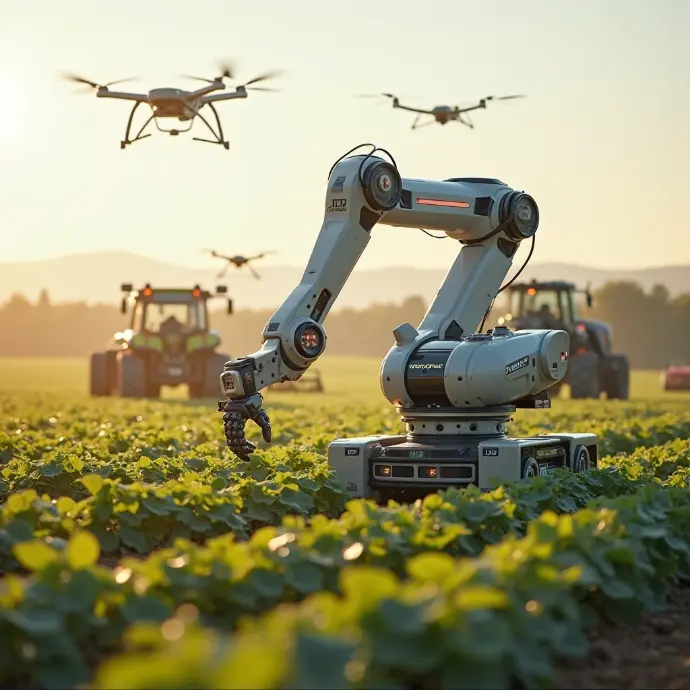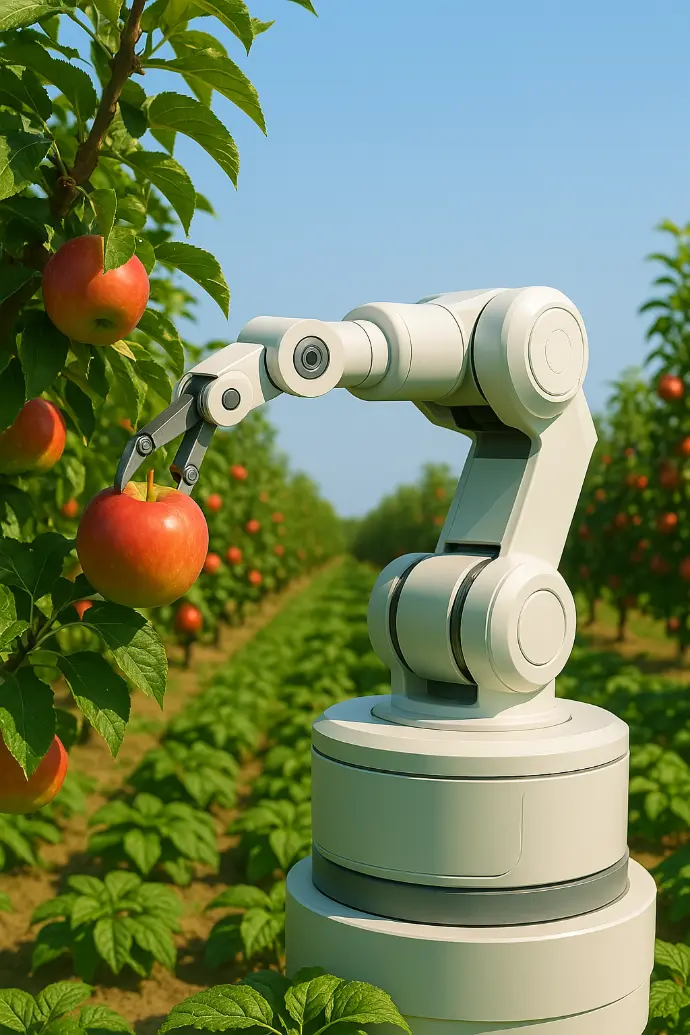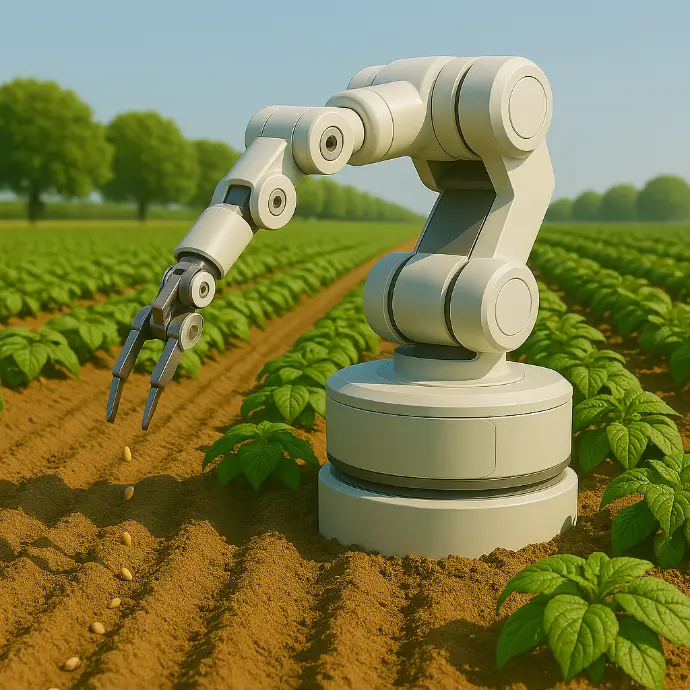The Economics of Robotics in Agriculture: Future Expense or Benefit?
In our feature article, "The Economics of Robots in Agriculture: Cost or Long-Term Investment?", you'll discover how robotics and autonomous systems are transforming agriculture. Have you wondered how this will impact the economy? Join us on this journey to find out!
Introduction
The integration of robotics in agriculture has sparked a revolution in the sector, transforming the way crops are grown and harvested. Agricultural robots are designed to perform a variety of tasks, from planting and irrigation to harvesting and processing, leading to increased efficiency and productivity in farming operations.
These autonomous robots are equipped with advanced technology, including sensors, cameras, and machine learning algorithms, allowing them to navigate uneven terrain, identify and classify crops, and apply treatments accurately and efficiently. This technological revolution is transforming traditional agriculture into precision farming, with the potential to optimize resource use and reduce environmental impact.
The adoption of robotics in agriculture is on the rise, with a wide range of robots ranging from small drones to large autonomous machines. This trend is redefining the agricultural landscape and raises important questions about the short- and long-term economic impact of this transformation.
The introduction of robotic technology in agriculture has had a significant impact on the sector. Automating farm tasks has allowed farmers to increase the efficiency of their operations, reduce labor costs, and optimize the use of inputs. Furthermore, the ability to collect detailed data on crop yield and soil conditions has provided farmers with valuable information for data-driven decision-making.
Technology has also improved sustainability in agriculture by enabling the precise application of inputs, reducing waste, and minimizing environmental impact. Agricultural robots have paved the way for more efficient and environmentally friendly farming practices, which is critical in a context of growing awareness about the importance of sustainability in food production.
Furthermore, robotic technology has opened up new opportunities for precision agriculture, allowing farmers to monitor and manage their crops more effectively. This has contributed to increased farm productivity and profitability, while reducing reliance on manual labor and improving working conditions.
The incorporation of robots in the agricultural sector presents a variety of advantages, but also entails significant obstacles. These advantages include increased operational efficiency, reduced long-term costs, reduced reliance on seasonal labor, and a better ability to adapt to adverse weather conditions. Furthermore, the ability to collect and analyze detailed information provides farmers with essential data for making strategic decisions.
However, the introduction of robots in agriculture faces significant difficulties, ranging from the initial expense of their acquisition and implementation to the need for specialized training and maintenance. Compatibility with existing systems and adaptation to current agricultural infrastructure also pose additional challenges. Additionally, there is growing concern about the potential impact on traditional agricultural employment, raising questions about the balance between automation and job protection in this sector.
While the adoption of robots in agriculture brings multiple benefits, it also poses crucial challenges that must be addressed holistically to ensure an effective transition to a more technological and sustainable agricultural model.
The Economics of Robots in Agriculture
The implementation of robots in agriculture can represent a significant initial outlay, but in the long term, it can be a highly profitable investment. In the short term, costs are optimized thanks to the automation of tasks such as cultivation, sowing, and harvesting. Robots can operate 24 hours a day, reducing the need for human labor and, consequently, the costs associated with salaries and benefits.
Furthermore, the precision in the application of fertilizers, pesticides, and water, thanks to robot technology, leads to a reduction in input waste, which positively impacts production costs. Despite the initial investment, the economics of robots in agriculture are evident from the outset, as costs are immediately optimized.
Investment in robotic technology in agriculture translates into a reduction in operating costs, which can have a positive impact on the financial balance of farms, making it an effective strategy for optimizing crop economics.
The incorporation of robots in agriculture not only leads to cost optimization but also significantly improves agricultural efficiency and productivity. Robots can perform tasks more quickly and accurately than human workers, resulting in a considerable increase in productivity. This improved efficiency translates into increased agricultural production, which in turn can positively impact economies of scale and farm profitability.
By reducing the time required to perform tasks such as sowing, irrigation, or harvesting, robots allow farmers to perform multiple tasks simultaneously, increasing operational efficiency and optimizing available resources. This increased efficiency contributes to boosting crop economics by enabling higher production with lower costs in time and resources.
The implementation of robots in agriculture not only optimizes costs but also boosts agricultural efficiency and productivity, generating a positive impact on crop economics and farm profitability.
Robots in agriculture not only represent an opportunity to optimize costs and improve efficiency, but also contribute to reducing occupational risks and associated costs. By performing dangerous or repetitive tasks, robots reduce workers' exposure to risky situations, which in turn can translate into reduced costs associated with workplace accidents and occupational health care.
Furthermore, the automation of agricultural tasks using robots allows farmers to overcome the challenges of labor shortages, especially during critical periods such as planting and harvesting. This reduction in dependence on human labor not only impacts cost optimization but also contributes to maintaining operational continuity and farm productivity.
The incorporation of robots in agriculture not only represents an opportunity to optimize costs and improve efficiency, but also contributes to reducing occupational risks and associated costs, generating a positive impact on the economy of crops and the occupational safety of agricultural workers.
The impact of implementing robots in agriculture on long-term profitability is significant. Despite the initial investment required to acquire and configure robotic technology, the long-term benefits can far outweigh these costs. Robots in agriculture can increase production efficiency, reduce operating costs, and minimize reliance on human labor. This translates into increased productivity, lower labor costs, and resource optimization, which in turn positively impacts long-term profitability.
Furthermore, the robots' ability to operate 24/7 allows for increased production and harvesting compared to traditional methods. The precision and consistency of the tasks performed by robots also contribute to a reduction in waste and loss, which directly impacts profitability over time.
It's important to consider that while the initial investment may be challenging for many farmers, the long-term return on this investment can be significantly higher, leading to an overall increase in the profitability of the farming operation. This shows that the adoption of robotic technologies in agriculture is not just a matter of cost, but rather a strategic investment to ensure sustainability and competitiveness in the market.
Factors to Consider When Implementing Robots
The economic viability of robots in the agricultural sector is profoundly affected by the initial purchase expense and long-term maintenance costs. Although the initial investment may be considerable, it is essential to consider the potential labor savings and efficiency improvements that these systems can provide to agricultural operations. Furthermore, when analyzing cost, it is essential to consider the robot's durability and maintenance costs throughout its lifecycle.
Current robotic systems for agriculture are optimized for energy efficiency and require regular maintenance to ensure effective performance. Although the acquisition price may be high, the long-term investment can result in significant savings and increased production.
It is essential to consider the long-term return on investment when analyzing the initial purchase and maintenance costs of robots in agriculture, as these systems have the potential to provide significant economic benefits over time.
The incorporation of robots in agriculture not only translates into expenditures on technology, but also into investment in worker training and adaptation. It is essential to provide adequate training to employees so they are able to operate and maintain robots efficiently. Furthermore, worker adaptation to the inclusion of robots in the workplace requires careful management and effective communication from employers.
Training workers in the use of agricultural robots can require considerable resources, both in terms of time and money. However, a trained and technologically adapted workforce can maximize the advantages of robot implementation, increasing operational efficiency and ensuring a more robust long-term return on investment.
Workforce adaptation to the integration of robots in the agricultural sector can also bring additional benefits, such as the acquisition of technical skills and an overall improved work environment, contributing to greater employee satisfaction and retention.
The incorporation of robots into agricultural infrastructure with pre-existing infrastructure is a vital aspect to consider from an economic and efficiency perspective. Robots must be able to operate seamlessly within the existing agricultural environment, which may require modifications to the infrastructure or the adoption of complementary technologies.
It is crucial to examine how robots fit into current agricultural infrastructure, including irrigation systems, storage spaces, and cultivation methods. The additional investment required to incorporate robots into existing infrastructure must be factored into the long-term cost-benefit analysis.
Effective integration of robots with agricultural infrastructure can result in significant improvements in efficiency, crop quality, and overall business profitability. Therefore, it is vital to carefully evaluate the integration of robots into long-term agricultural planning and strategy.
The introduction of robots in the agricultural sector has the potential to have significant effects on the environment and the community. From an environmental perspective, automation in agriculture could reduce the need for pesticides and harmful chemicals, allowing robots to apply fertilizers and biocides more accurately and efficiently. This could result in reduced pollution in water bodies and soil, as well as a decrease in greenhouse gas emissions from conventional agricultural machinery.
Regarding social effects, the integration of robotic technologies in agriculture could transform the employment situation in rural areas. Although automation may precipitate a lower demand for workers for repetitive agricultural activities, it also has the potential to create new opportunities in more specialized professions related to the maintenance and operation of robots. Furthermore, increased efficiency in agricultural production could promote food security and reduce poverty in rural communities worldwide.

Case Studies: Inspiring Success Stories in Robotic Agriculture
Robotic agriculture has ceased to be just a futuristic vision and has become a reality that is transforming agriculture. Through the implementation of advanced technologies, many farmers and innovators have found effective ways to maximize productivity, reduce costs, and implement more sustainable practices. Below, we'll take you through some successful experiences that demonstrate how robots are revolutionizing the way we grow our food.
For example, autonomous tractors equipped with artificial intelligence (AI) systems are being used in large agricultural fields in North America. These vehicles not only eliminate the need for manual driving but also detect and respond to soil conditions in real time, adjusting to ensure optimal performance. The result: more efficient harvests with a lower environmental impact.
In Asia, particularly in countries like Japan and China, robotization has led to automated vertical farms that produce vegetables and fruits year-round. These crops don't require large areas of land and use up to 90% less water than traditional methods. It's surprising how the use of robotic arms for sowing and harvesting has optimized time and significantly reduced losses.
On another level, in Europe, drones are being adopted to monitor farms from the air. These devices not only generate detailed maps of crop status but can also spray only where necessary. This localized approach reduces pesticide use and facilitates eco-friendly agricultural practices.
These cases are not just isolated stories, but clear examples of the impact of adopting robotic technologies in agriculture. As these practices expand to more regions around the world, they are emerging as a key to addressing global challenges such as population growth and climate change.
Without a doubt, robotic agriculture not only improves present productivity but also offers us a window into a more sustainable and innovative future. What other advances will we see in the coming years? The countryside remains fertile ground for new ideas and possibilities.
AgroTech, a leading company in the implementation of agricultural technologies, has achieved a significant increase in productivity by incorporating robots into its operations. By using robots equipped with artificial vision systems and robotic arms, AgroTech has optimized tasks such as cultivation, harvesting, and crop maintenance. Thanks to this implementation, the company has managed to increase its productivity by 30% compared to traditional methods.
This increase in productivity has allowed AgroTech not only to improve its profitability, but also to optimize its resources, reduce operating costs, and improve the quality of its products. The investment in agricultural robotics has proven to be a strategic decision that has positioned AgroTech as a benchmark for innovation within the agricultural sector.
The implementation of robots in agriculture has allowed AgroTech not only to increase its efficiency but also to reduce its dependence on human labor, which has been especially beneficial in contexts of labor shortages or health crises that affect the availability of agricultural workers.
At Granja El Progreso, the implementation of robotic technologies in its agricultural processes has resulted in significant savings and greater operational efficiency. By incorporating robots for tasks such as irrigation, planting, and crop monitoring, the farm has managed to reduce its water consumption by 20% and decrease its use of agrochemicals by 15%.
Furthermore, the automation of processes through robots has allowed Granja El Progreso to optimize the use of fertilizers and pesticides, thus reducing its environmental impact and improving its sustainability. These results have positioned the farm as an example of good practices in the use of emerging technologies for agriculture.
The initial investment in adopting robots and autonomous systems has proven to be a wise decision, as the savings in operating costs and increased efficiency have more than offset the initial investment, demonstrating that robotics in agriculture represents a long-term investment with positive economic and environmental impacts.
At Sustainable Farming, the implementation of robotics in its agricultural processes has had a positive impact on its sustainability. By using robots for soil maintenance, pest control, and crop monitoring, the farm has reduced its environmental footprint and improved the health of its soil and crops.
Furthermore, robotics has allowed Sustainable Farming to optimize the use of natural resources, reduce waste, and improve production efficiency, resulting in increased profitability and a more sustainable and environmentally friendly brand image.
The implementation of robotics in Sustainable Farming has demonstrated that the adoption of emerging technologies can not only improve productivity and profitability, but also contribute significantly to the long-term sustainability and preservation of the agricultural environment.

Future Considerations and Trends
Agricultural robotics has experienced significant advances in recent years, driven by the development of emerging technologies. These advances have enabled the creation of robots and autonomous systems capable of performing specific tasks in the field, such as sowing, irrigation, and harvesting, with unprecedented levels of precision and efficiency. The integration of artificial intelligence and machine learning has further enhanced these capabilities, allowing agricultural robots to make real-time decisions based on autonomously collected and analyzed data. This increase in the operational capacity of agricultural robots represents a significant milestone in the evolution of technology applied to the sector.
Furthermore, agricultural robots capable of operating in different types of terrain and weather conditions have been developed, expanding their scope of application. For example, robots designed for uneven terrain or steep slopes have enabled the automation of tasks in areas previously inaccessible to conventional machinery. These technological advances have opened up new possibilities and transformed the way challenges in agriculture are addressed, paving the way for greater integration of robots into production processes.
The agricultural robotics industry is constantly evolving, and technological advances are expected to continue driving the development of increasingly sophisticated and versatile robots in the coming years. This trend points toward greater automation of agricultural tasks, which promises to optimize productivity, reduce costs, and mitigate the environmental impacts associated with conventional agriculture.

Conclusions
Technological advancements in robotics are reshaping the agricultural industry, unlocking transformative opportunities to enhance its efficiency, profitability, and sustainability. The integration of robotic systems into farming practices not only means a leap forward in technology but also paves the way for unprecedented economic and environmental gains within the sector. By conducting an in-depth analysis, the significant long-term advantages these automated solutions can offer to producers become evident. The economics of robotics in agriculture presents a multifaceted challenge that demands thorough assessment of upfront investments, operational performance, and anticipated long-term benefits.
Evaluating the viability of adopting such technology requires careful consideration of its potential impact on sectoral profitability and environmental sustainability. Although the initial acquisition and upkeep of robotic systems involve considerable financial input, their ability to enhance productivity, streamline processes, and reduce costs over time can convert these investments into substantial economic returns. To ensure the successful adoption of robotics in agricultural practices, several critical factors must be taken into account. Addressing the specific needs of the operation, providing adequate workforce training, ensuring compatibility with existing systems, and planning for ongoing equipment maintenance are pivotal steps for a smooth transition to automation. Careful attention to these elements will be key to realizing the full potential of robotic technology in revolutionizing agriculture.

 IHRO NEWS
IHRO NEWS